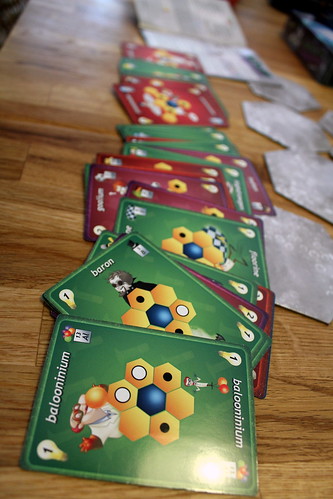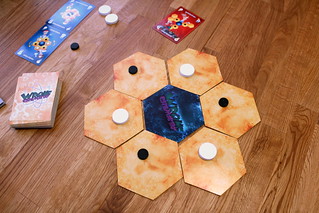Post by exazarius on Nov 11, 2012 10:08:17 GMT

Our review copy of Wrong Chemistry was generously supplied by publisher Mage Company. Thanks a lot!
In a large, labyrinthine laboratory so deeply underground that it doesn’t even matter what part of the world it’s in, a duo of really raving mad scientists have set out to revolutionize chemistry. They are not at all happy with the way the periodic table was mostly built, top-down by splitting molecules and seeing what kind of atom falls out. Their approach is bottom-up, building all the elements from the basic building blocks of matter: hexagonal tiles, big white disks and small black disks. What? Electrons? Neutrons? Quarks? Okay, if you want to wait for Right Chemistry to come out as a game, be my guest, but for now we’re playing Wrong Chemistry.

The Periodic Card Table
Let’s hope those scientists know what they’re doing, I’m really not convinced. There’s no word about world domination at all, Standards in mad scientistness must be slipping. That’s probably why the demented duo lets you do all the work while they’re in the background cracking brain-shatteringly bad puns – and I mean that as a compliment, I enjoy a good punch to my Wernicke’s area. Most of those puns are really, really bad: the card for iron depicts the cloth flattening tool and potassium prominently features a donkey and a pot – don’t even get me started on pawlawnium. But some actually take a moment of thought before they start hurting: nickel shows two vaguely familiar figures that turn out to be Nick Fury and Kal-El – aka Superman. Nick-El. Get it? Each of the 54 element cards is individually illustrated in family friendly cartoon style: those mad scientists didn’t spare any expenses when getting you to do their work.
At least they gave you one copy of the basic state of matter to work with: a ring of six hexes around the dark central tile, with alternating black and white disks on them. This basic state is so neutral, it’s literally nothing. It’s the atom less complex than hydrogen – sorry, highdrawgen – and that’s why it’s not worth any points. You really only get one copy of it, you have to share it with the other players. On your turn, you should try to complete the research assignments in your hand, configurations of the game elements on the table that make a certain chemical element. To get there, you may take four actions each turn, picked freely from this list: add or remove one of the wooden disks, move a disk to another hex, move a hex without a disk to somewhere else. Somewhere on the table, that is. Moving one of the tiles to your pocket is considered bad style even among the maddest of scientists. When you complete an element, you show the card around the table – this is not an action – gloat a little – also not an action, but may end your turn in other ways – and put the card on your score pile where it counts from one to three points, depending on the element’s complexity.

The Basic State of Matter
Then you pass the atom to the next player and let him deal with the horrible mess you’ve made of things that doesn’t go with his cards at all. If things are really that bad, there’s always the mystical element Restartium that, once per turn, puts all matter back into the basic state. I hope they don’t weaponize this in their inevitable quest for world domination, the effects of a restartium bomb on a densely populated area would be horrific. A second special element adds some more strategy to the game: Extramovium lets you take three extra actions at the cost of discarding one card from your score pile, as many times as you like as long as you can keep discarding. Extramovium is often your only chance to create the more complex elements like Hatium where your fellow lab assistants are not likely to leave a half-completed atom lying around for you. It sounds like an easy choice to discard one point and gain three, but there’s a little something in the scoring rules to make you think for a moment.
When the game ends – when the draw pile is empty – all your elements are worth the points printed on the card. But that’s not all, you get extra points for having elements with consecutive atomic numbers. They’re printed on the cards, you don’t have to learn the periodic table if you don’t want to. Each card from such a set is worth an extra point – and suddenly discarding to activate the Extramovium is a tougher decision, you wouldn’t want to discard a low card when you already have more in the general vicinity and have hope to find the element that connects them.

Pawlawnium
Tony Cimino’s Wrong Chemisty is not a deep, complex game to spend a whole evening on, and it’s not the first game where you have to duplicate a given shape to score points, but it’s a very nice implementation of the concept. Player interaction is limited to giving bad names to other players for the utterly useless mess they left for you, but in this type of game I actually prefer low interaction to the forced interactivity of mess-with-you action cards. I’m glad there’s none of those here. There is still some luck involved in winning: if your cards match the cards of the player just before you, you’ll have a much easier time completing your research, but over the course of a whole game, it’s very unlikely that that luck should hold. It’s mainly your pattern-matching ability tha lets you win. A word of advise there: watch the symmetry. Many when you think your card is only a rotation of the element on the table – a perfectly valid way to score – it really is the mirror image and no one will let you take points for that. Curse you, Einsteinium and your asymmetry!
In the end, Wrong Chemistry is a quick, family friendly game that you can also enjoy with your gamer friends sometimes, for a game or three. For a game called Wrong Chemistry, it’s doing many things just right.




